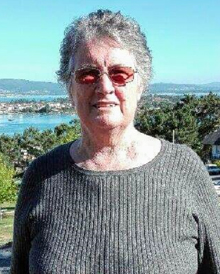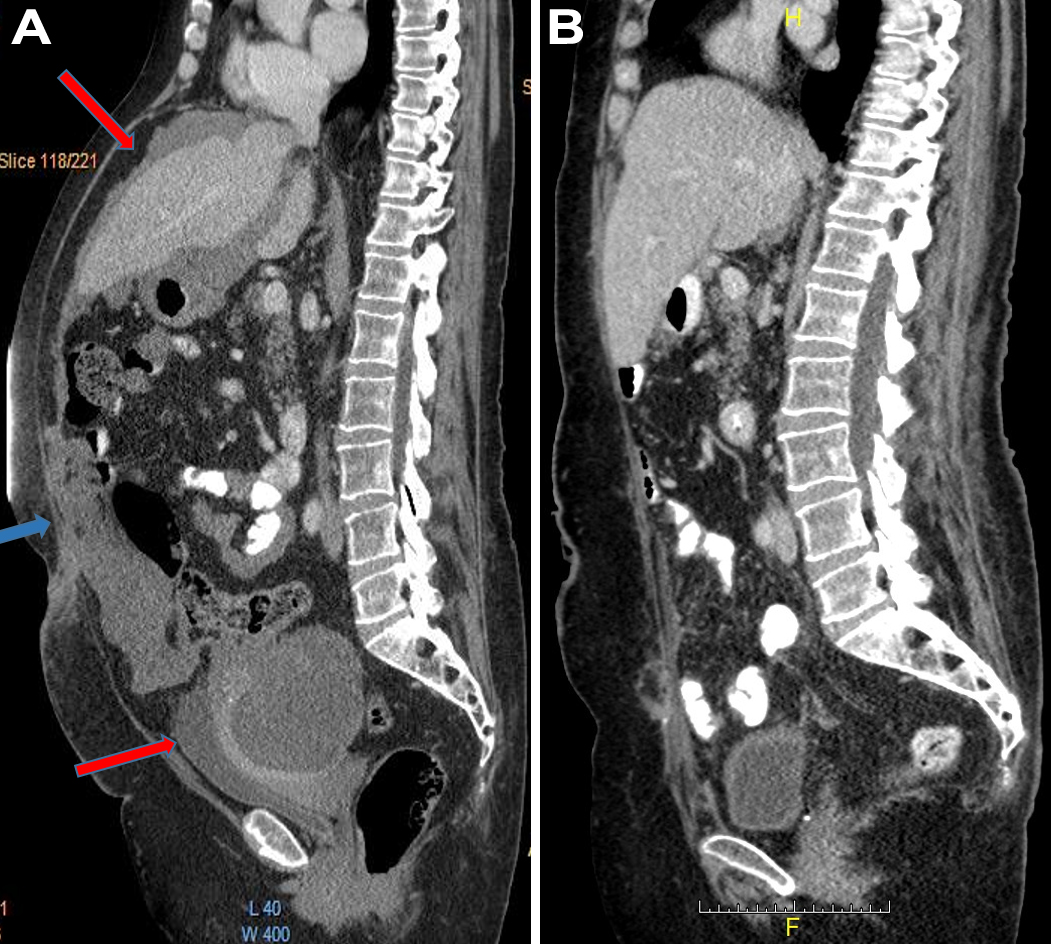We are very pleased to share the stories and testimonials of patients who have come to Stony Brook Cancer Center to receive cytoreductive surgery and HIPEC. Many of our patients travel to Stony Brook from afar, often after discouraging visits at other cancer centers where they were told no further treatment was possible. But when hope was needed most, they found our Surgical Oncology Division, whose team treated them and gave them back their lives. The case histories here contain some medical terms that are explained in the glossary below.
- Mrs. Rosa M, 71 years old, from Spain, with appendiceal cancer
- Ms. Adriana P, 70 years old, from Long Island, with appendiceal cancer
- Ms. Annette T, 75 years old, from New Jersey, with peritoneal cancer
- Mr. Brian D, 48 years old, from Long Island, with appendiceal cancer
Mrs. Rosa M

| Mrs. Rosa M back in Spain, after surgery with HIPEC provided at Stony Brook. |
Mrs. Rosa M is a 71-year-old Spanish woman who had a mucinous appendix tumor, a rare and poorly understood disease. Her initial symptoms included abdominal fullness and pain. She sought treatment with her physicians in Spain who diagnosed her with cancer that spread throughout the abdominal cavity. The doctors were uncertain of the cancer's exact origin, but they felt that she was inoperable and placed her on chemotherapy to relieve her symptoms.
Mrs. M's children brought her to the United States where they sought second opinions. They were told that chemotherapy was the only treatment option at one cancer center, and at another center, they were told that surgery would likely fail to remove all the disease. She came to Stony Brook where extensive cytoreduction with HIPEC was successfully performed to remove all the disease.
Although the operation was complex and the hospitalization long, Mrs. M and her husband are now enjoying her disease-free days back in Spain. Her only complaint is the nerve damage from the unnecessary chemotherapy that she received. We have asked her a few questions about her experience with this complicated disease.
"My doctors in Spain told me there was no treatment for my cancer."

| CT scan images show the changes in abdominal distension before (A) and after (B) cytoreduction and HIPEC. On the left (A), the patient has the classic "jelly belly" appearance with protrusion of the abdomen from massive accumulation of mucin. There is mucin around the liver and in the pelvis (red arrows). There is a large omental cake at the anterior abdominal wall (blue arrow). On the right (B), several liters of mucin were removed during surgery leading to a flat abdominal wall. The mucin is no longer present anywhere in the abdomen, and the omental cake has been removed. (Click on image to enlarge.) |
Q: What did your original physicians tell you about your disease and its likely course?
A: I was diagnosed in November 2015 with peritoneal carcinomatosis. I was told it probably originated in an ovary or in my small bowel. It was deemed untreatable, and I was given six to nine months to live. I was placed on palliative chemotherapy (Folfox 6).
Q: Were you ever told that there was no more possible treatment for your disease?
A: Yes, my doctors in Spain told me there was no treatment for my cancer. I was later told the same in consultations at both Dana Farber in Boston (where the doctor told me straight out "this is a life-ending event") and at Memorial Sloan Kettering Cancer Center in New York, where they originally concurred with my Spanish doctors in continuing with chemotherapy adding Avastin. Later, a surgeon at Sloan suggested a laparoscopy to do exploratory surgery to determine if complete cytoreduction were possible, and if not, to do partial surgery and follow with chemo.
Q: How did you learn about cytoreduction surgery and HIPEC at Stony Brook?
A: I learned about cytoreduction with HIPEC by reading about treatment options for peritoneal carcinomatosis, and came across Dr. Paul Sugarbaker's work in the area. I only learned of Stony Brook Medicine the week before my consultation in October 2016. To this day, I can't really explain how, as Stony Brook had never before come up in my many Internet searches for treatment. Thank God, it finally did!
Q: What is your current level of activity? Is it back to baseline or close to getting there?
A: My level of activity is at, or slightly better than, where it was just before surgery, though I'm still suffering the effects and damage of the neuropathy caused by chemotherapy. But I'm regaining strength on a daily basis.
Ms. Adriana P
Ms. Adriana P is a 70-year-old Long Island woman who had cancer of the appendix that spread throughout her abdomen. She didn't have any symptoms that she thought were due to the cancer. She was working and life was normal.
She started the year 2016 not feeling well and went to a local urgent care clinic where she was diagnosed with pneumonia. After one week, she still felt that something was wrong, and so she returned to the urgent care clinic. They informed her that the pneumonia was gone, but on physical examination the doctor found a very painful spot on the right side of her abdomen.
Ms. P had this pain for years and her family doctor had attributed this pain to diverticulosis, an inflammatory condition of the colon for which she was taking medicine.
The urgent care doctor believed the pain could be appendicitis and sent her for radiologic studies. A CT scan showed spread of cancer throughout the entire abdominal cavity but did not identify an origin for its spread. She said, "The scans showed cancer cells were swimming in my belly."
Based upon these results, Ms. P was asked to see a cancer specialist. She saw multiple physicians and even had a colonoscopy which was reported to be normal. With her ever worsening physical condition and the unknown origin of her cancer, a local oncology doctor referred Ms. P to Stony Brook. Even though she had a normal colonoscopy, our surgical oncologist used his experience to diagnose her with cancer of the appendix.
Our surgical oncologist recommended surgery to treat her disease. She sought another opinion in New York City, but was disappointed with the treatment options. She chose to undergo surgery at Stony Brook. The operation took 15 hours. All the sites of disease were removed, including multiple organs. She was in the hospital for three weeks, including 12 days in the intensive care unit. She didn't have any complications, but it took a while for her to fully recover from the surgery.
"After my treatment at Stony Brook, I had a CT scan that showed no sign of cancer."
Q: What would you say to someone considering HIPEC?
A: I would say to just go and do it. I looked for a second opinion at Sloan Kettering, but at Sloan, the computer chooses the kind of treatment and operation for you. I didn't like that, so I continued at Stony Brook.
After my treatment at Stony Brook, I had a CT scan that showed no sign of cancer. I remain cancer free, and will have regular follow-ups with an oncologist to make sure the cancer cells don't come back.
Q: What is your current level of activity? Is it back to baseline or close to getting there?
A: Once I recovered from my operation and the “normal” chemo I had after it, I now have the same quality of life I had before all the treatment. The only thing is that I feel a little more tired sometimes, but I am working on getting my energy back up to where it was. I walk every day for six blocks.
I love to garden flowers in my yard. Every year, I plant around 200 flowers. Last year, I was only able to plant seven myself. But this year, I feel stronger and can get back to my garden.
Q: What would you say to your surgical oncologist at Stony Brook?
A: I would tell him I love him. He saved my life. Sometimes I would go to his office and cry. And he would say strong words to me, but I think that's part of being a doctor. He said everything so clear to me, even sometimes when I didn't want to hear it, but I know it's his responsibility to tell me the truth.
My whole family respects him and both of my children know him well. Last year on Thanksgiving, my son sent him a message to thank him for saving my life.
I want to share my story, in hopes of helping someone else. When my family and I were researching our options and who should perform an operation, I found that he was really the only person I would trust in the area.
Ms. Annette T

| Ms. Annette T after treatments provided at Stony Brook. |
Ms. Annette T is a 75-year-old woman from New Jersey. In May 2015, she suffered from occasionally severe abdominal pain which was accompanied by bloating and constipation. When the pain continued to progress over the next two to three months, she sought help from her family doctor. A CT scan was ordered, and it showed abnormal fluid in the abdominal cavity and a possible mass on her colon.
Ms. T was referred to see a specialist in colorectal surgery, who scheduled an operation. During the procedure, the surgeon identified cancer spread throughout the abdominal cavity, which he explained to Ms. T as numerous "marbles" of cancer. He closed the abdomen after performing a minor biopsy.
Ms. T was referred to an oncologist who diagnosed her with stage 4 primary peritoneal cancer, a rare cancer that develops in the lining of the abdominal cavity. The doctor told her that she had two months to live without aggressive chemotherapy treatment.
Even with chemotherapy, the disease persisted and that doctor was running out of options — until he saw a Stony Brook surgical oncologist speak at a seminar on cytoreductive surgery and heated intraperitoneal chemotherapy (HIPEC). After completing ten cycles of chemotherapy, Ms. T was referred by him to go to Stony Brook to see the surgical oncologist there.
"HIPEC worked for me. . . . I can't thank Stony Brook enough for saving my life."
Stony Brook's surgical oncologist agreed with the diagnosis of primary peritoneal cancer, and performed a careful review of the imaging studies. Despite the specialist in colorectal surgery saying that surgery was not possible, the Stony Brook surgeon felt that he could remove all of her disease.
On April 2, 2016, he performed a 10-hour operation. Ms. T was in the hospital for about five days. Ms. T says: "I was immediately willing to give HIPEC a chance. God gave me the opportunity, and I was taking it." After recovery from her surgery, Ms. T says that she returned to her normal quality of life.
About one year later, a PET scan found a single site of recurrent disease, and Ms. T returned to Stony Brook in April 2017 to have a colon resection. This went so well that she only stayed in the hospital for two days, and is again cancer-free.
Ms. T loves to cook and entertain. When she was sick, she couldn't wait to be better to have her friends over for a luncheon. This coming June, she is excited to see her grandson graduate high school. She also hopes to volunteer more in the future, especially to give back to the people that have helped her along the way.
Ms. T says: "HIPEC worked for me, and if it is a possibility for others, I think they should see if it will work for them. I can't thank Stony Brook enough for saving my life. How could I be more grateful?
"The surgeon there who treated me was always amazing with communication with my daughter and me. He always followed up with us, got back to us quickly, answered all of our questions, and was reachable when we needed him."
Mr. Brian D

| Mr. Brian D after surgery and HIPEC provided at Stony Brook. |
Mr. Brian D is a 48-year-old Suffolk County Police Officer and father of five. He thought he pulled a muscle moving a TV, but when the pain persisted, he saw his doctor.
An MRI was ordered to evaluate the muscular pain, and the results were devastating: not only did he have an appendiceal tumor, but the disease had spread throughout his abdomen.
Mr. D was referred to see an oncologist who recommended Stony Brook Medicine.
The Stony Brook surgical oncologist concluded that without cytoreductive surgery and HIPEC Mr. D's chance of survival for up to two years was 0%. But as he told him, surgery in combination with HIPEC offered him a chance of survival greater than five years was over 50%.
After a complete evaluation, the Stony Brook surgical oncologist knew that Mr. D's only hope was cytoreductive surgery and HIPEC.
In December 2016, Mr. D had surgery at Stony Brook to remove the ruptured appendix cancer and also all of the tumors that had spread throughout the abdomen.
While in the operating room over the course of the 14-hour surgery, the surgeon and his team also used HIPEC to deliver heated chemotherapy in high doses to maximize absorption of the drugs and target hidden cancer cells in the abdomen.
Mr. D's hospital course was smooth, and he was discharged to home in one week without any complications. He has let his hair grow out, and is enjoying taking care of his children at home, while his wife (also a Suffolk County Police Officer) is busy at work.
| Glossary of Medical Terms
Carcinoma. Another term for cancer. Cytoreduction or cytoreductive surgery. Removal of visible sites of cancer/disease (see FAQs). HIPEC. Acronym for heated intraperitoneal chemotherapy; it is the administration of hot chemotherapy during the cytoreduction operation (see FAQs). Jelly belly. The massive accumulation of mucin within the abdominal (belly) cavity. Mucin. Another term for mucous, which is produced by glands for lubrication and protection of organs. Mucinous appendiceal neoplasm. A term that covers a broad range of mucin-producing tumors of the appendix, including benign appendiceal cystadenoma, appendiceal adenocarcinoma, and goblet cell cancer of the appendix. Neoplasm. Another term for tumor, growth, or mass. Omental cake. The accumulation of mucin and cancer within the fatty drape of tissue in the abdominal cavity. Peritoneal carcinomatosis. The diagnosis of metastatic cancer in the abdominal cavity; the original site of the cancer can be from any organ or tissue. Tumor. Non-specific term for mass or growth. |
